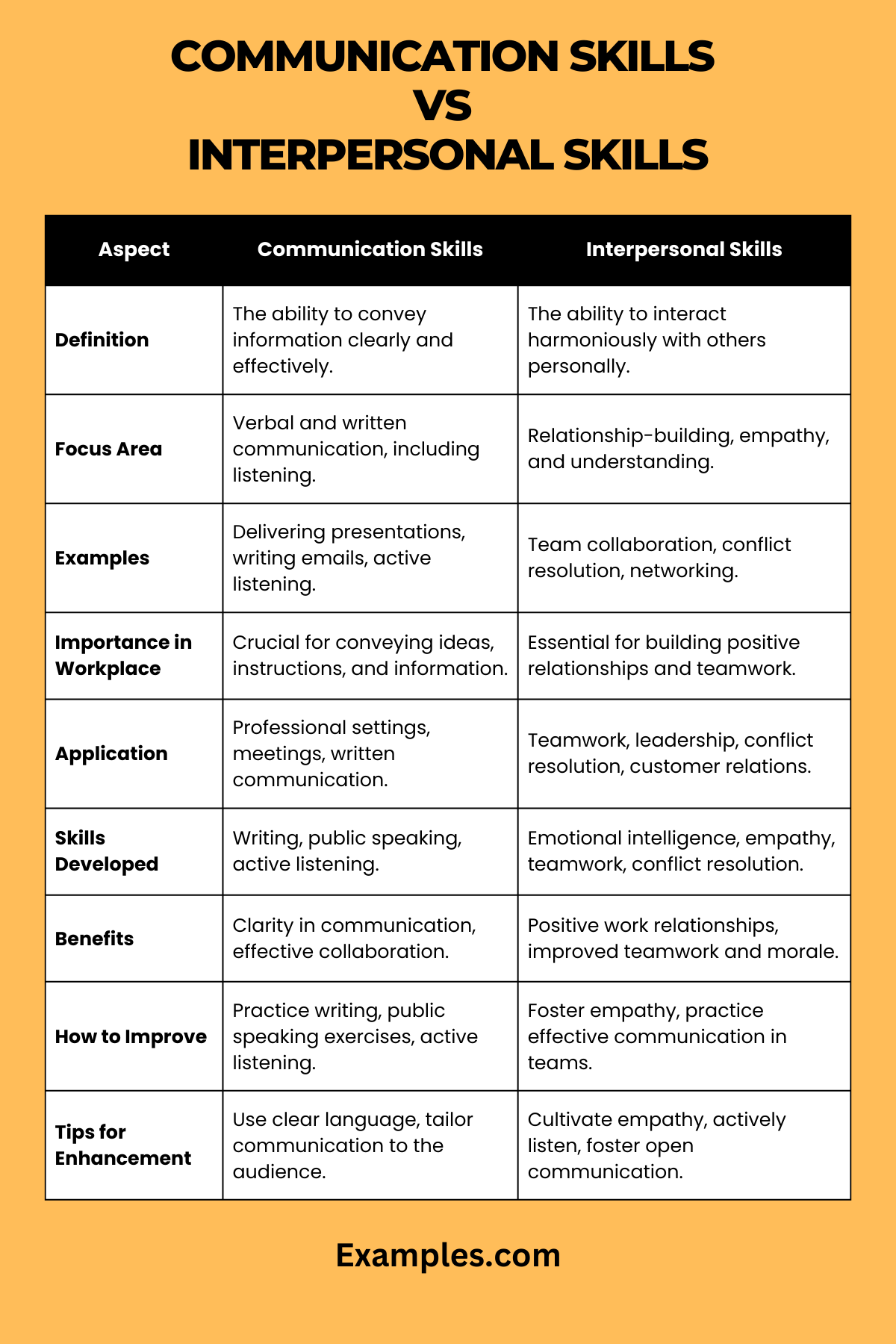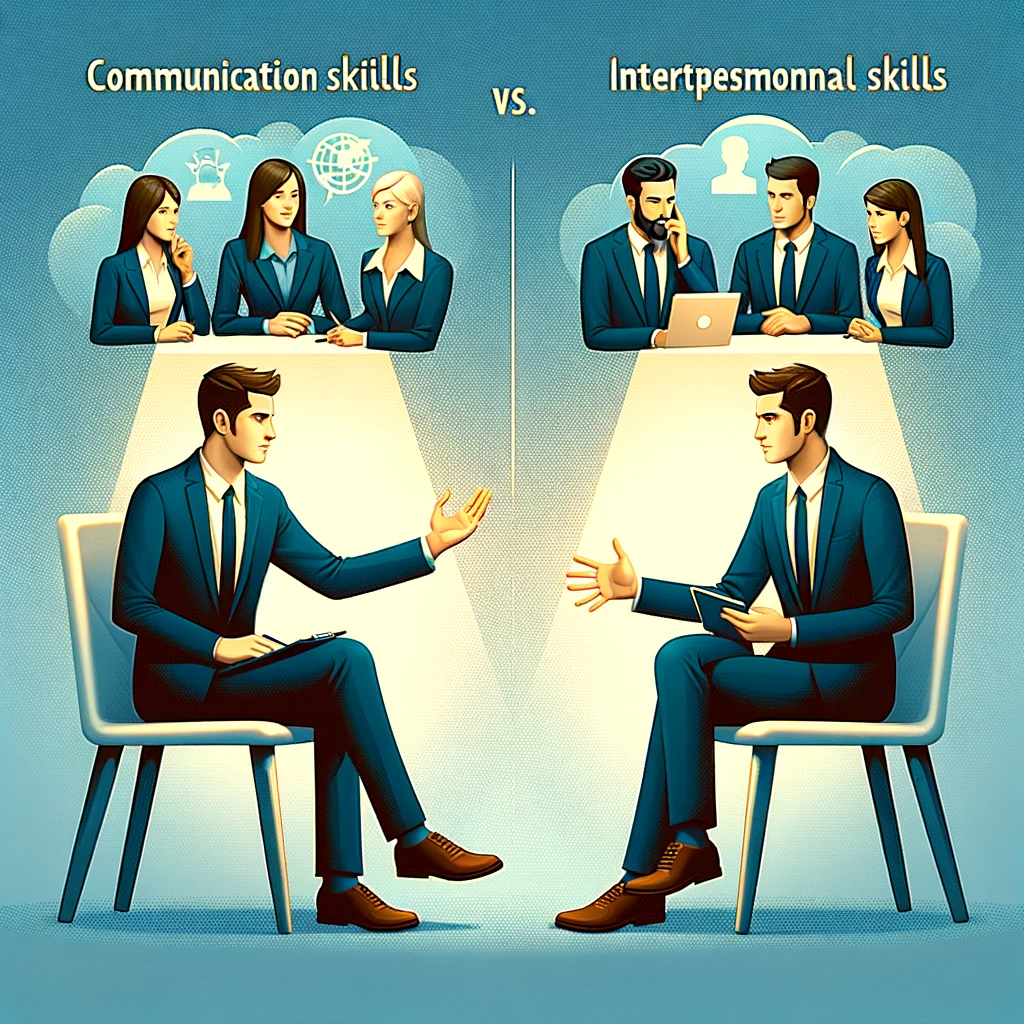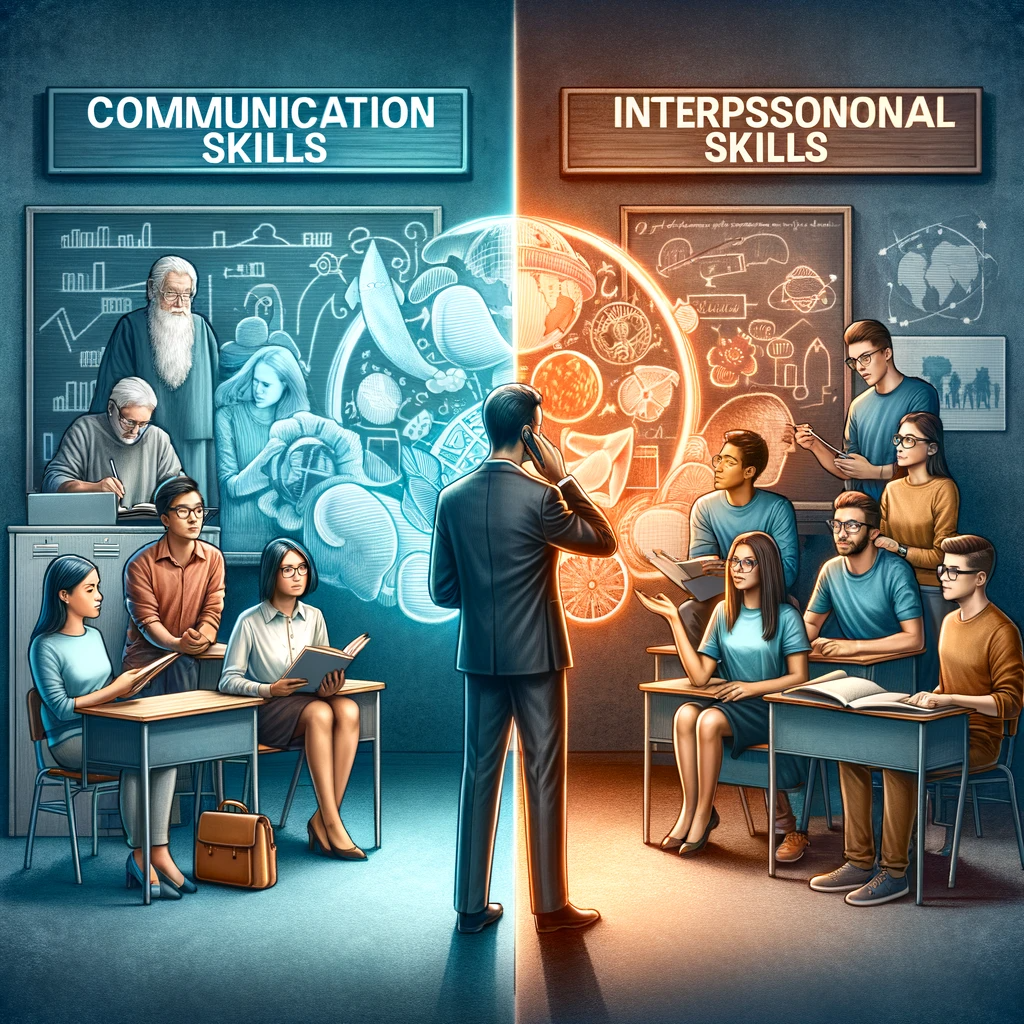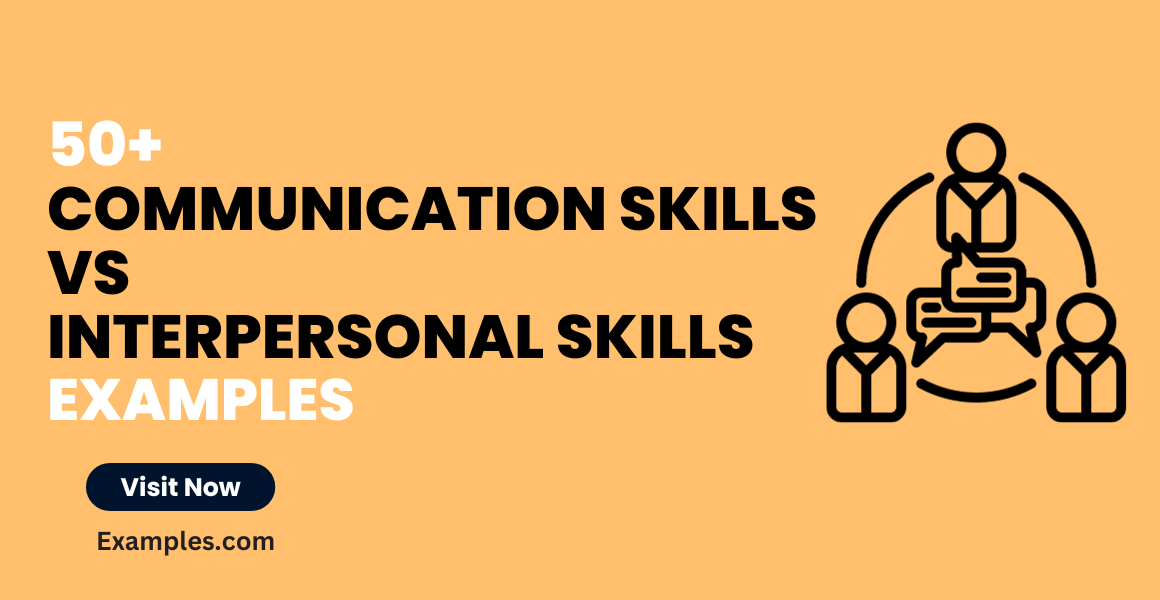Communication Skills vs Interpersonal Skills
Embark on a captivating exploration of Communication Skills vs Interpersonal Skills. This in-depth guide unfolds the origins and history of these pivotal skills, offering clear definitions and illuminating examples. Dive into the intricacies of honing both sets of skills, and discover practical advice on mastering effective communication. From the roots to the tips, enrich your understanding and elevate your interactions with this holistic journey into the realm of communication expertise.
Differences between communication skills and interpersonal skills

50 Communication Skills vs Interpersonal Skills Examples
Enhance your understanding of these skills with real-world scenarios. From workplace dynamics to personal connections, these examples illustrate their nuanced application.
- Active Listening: Elevate conversations by focusing on the speaker, making them feel valued and understood.
Example: In a meeting, employ active listening to grasp colleagues’ perspectives, fostering collaboration. - Nonverbal Cues: Master the art of body language, using gestures and expressions to complement spoken words.
Example: Maintain eye contact and nodding during a presentation to convey engagement. - Empathy: Cultivate understanding and connect emotionally with others.
Example: Show empathy by acknowledging a colleague’s challenges and offering support. - Effective Feedback: Deliver constructive criticism positively for continuous improvement.
Example: Provide feedback to a team member on their project, highlighting strengths and suggesting improvements. - Conflict Resolution: Navigate conflicts diplomatically, finding solutions that benefit all parties.
Example: Mediate a dispute by encouraging open communication and seeking compromise. - Adaptability: Adjust communication style based on the audience and context.
Example: Tailor your message differently for a team meeting versus a client presentation. - Clear Communication: Express ideas concisely, avoiding ambiguity.
Example: Draft emails with clarity, ensuring recipients understand your message without confusion. - Team Collaboration: Foster teamwork by encouraging open communication and shared goals.
Example: Coordinate a project with team members, ensuring everyone’s insights are valued. - Conflict Management: Address conflicts promptly, seeking resolutions that preserve relationships.
Example: Handle interpersonal conflicts at work by addressing concerns and finding common ground. - Negotiation Skills: Navigate discussions effectively to reach mutually beneficial agreements.
Example: Negotiate terms in a business deal, ensuring a win-win outcome for both parties. - Time Management: Efficiently communicate priorities and deadlines.
Example: In a project, convey task deadlines clearly to ensure timely completion. - Problem-Solving: Collaboratively solve challenges by seeking input from diverse perspectives.
Example: Address a team challenge by brainstorming solutions and implementing the best course of action. - Leadership Communication: Articulate a vision and motivate others to achieve shared goals.
Example: Lead a team by communicating a clear vision and inspiring commitment. - Cultural Sensitivity: Adapt communication to respect cultural differences.
Example: Conduct business with international clients, considering cultural nuances for effective communication. - Networking Skills: Build professional relationships through effective communication.
Example: Attend a networking event, initiating conversations and building connections with industry peers. - Persuasion Skills: Influence others by presenting compelling arguments.
Example: Convince stakeholders to support a proposal through persuasive and well-structured communication. - Clarity in Instructions: Provide clear and concise instructions for task completion.
Example: When delegating tasks, ensure team members understand expectations through clear instructions. - Conflict Avoidance: Prevent conflicts by addressing potential issues proactively.
Example: Anticipate potential conflicts within a team and address concerns before they escalate. - Collaborative Decision-Making: Involve team members in decision-making processes.
Example: In a project meeting, make decisions collaboratively, considering diverse perspectives. - Open-Mindedness: Embrace new ideas and perspectives.
Example: Encourage team members to share innovative ideas, fostering a culture of open-mindedness. - Feedback Receptivity: Welcome constructive feedback for personal and professional growth.
Example: Receive feedback from a mentor with gratitude, using it as a tool for improvement. - Conflict De-escalation: Calm tense situations by maintaining composure and seeking resolution.
Example: Mediate a heated discussion by promoting calm communication and finding common ground. - Cross-Cultural Communication: Navigate communication across diverse cultural backgrounds.
Example: Engage in a conference call with international colleagues, adapting communication to diverse cultural norms. - Customer Service: Address customer concerns with empathy and problem-solving.
Example: Handle a customer complaint by actively listening and providing a solution with a positive attitude. - Leadership Communication: Inspire and motivate a team through effective leadership communication.
Example: Lead a team meeting by sharing a compelling vision and encouraging collaboration. - Delegation Skills: Effectively assign tasks based on team members’ strengths.
Example: Delegate responsibilities in a project, ensuring tasks align with each team member’s expertise. - Cross-Functional Collaboration: Foster collaboration among departments for comprehensive solutions.
Example: Facilitate communication between marketing and sales teams to enhance overall business strategy. - Conflict Transformation: Transform conflicts into opportunities for growth.
Example: Turn a team disagreement into a constructive brainstorming session, encouraging innovative solutions. - Remote Communication: Effectively communicate in a remote work setting.
Example: Conduct virtual team meetings, utilizing video conferencing and clear communication tools. - Decision Communication: Clearly communicate decisions and their rationale.
Example: Inform the team about a strategic decision, outlining the reasoning behind the choice. - Customer Relationship Management: Build and maintain positive customer relationships.
Example: Communicate regularly with clients, addressing their needs and ensuring satisfaction. - Email Etiquette: Exhibit professionalism and clarity in written communication.
Example: Compose professional emails, using proper etiquette and clear language. - Listening Skills: Actively listen to understand others’ perspectives.
Example: In a team meeting, practice active listening by giving full attention to colleagues’ ideas and concerns. - Networking Etiquette: Engage in professional networking with courtesy and respect.
Example: Attend a business networking event, introducing yourself with proper etiquette and genuine interest. - Appreciative Communication: Express gratitude and appreciation effectively.
Example: Acknowledge a team member’s contributions with sincere appreciation and specific praise. - Conflict Transformation: Transform conflicts into opportunities for growth.
Example: Turn a team disagreement into a constructive brainstorming session, encouraging innovative solutions. - Remote Communication: Effectively communicate in a remote work setting.
Example: Conduct virtual team meetings, utilizing video conferencing and clear communication tools. - Decision Communication: Clearly communicate decisions and their rationale.
Example: Inform the team about a strategic decision, outlining the reasoning behind the choice. - Customer Relationship Management: Build and maintain positive customer relationships.
Example: Communicate regularly with clients, addressing their needs and ensuring satisfaction. - Email Etiquette: Exhibit professionalism and clarity in written communication.
Example: Compose professional emails, using proper etiquette and clear language. - Listening Skills: Actively listen to understand others’ perspectives.
Example: In a team meeting, practice active listening by giving full attention to colleagues’ ideas and concerns. - Networking Etiquette: Engage in professional networking with courtesy and respect.
Example: Attend a business networking event, introducing yourself with proper etiquette and genuine interest. - Appreciative Communication: Express gratitude and appreciation effectively.
Example: Acknowledge a team member’s contributions with sincere appreciation and specific praise. - Team Building Communication: Foster team cohesion through effective communication.
Example: Organize team-building activities, encouraging open communication and collaboration. - Trust-Building: Establish trust through transparent and honest communication.
Example: Build trust within a team by openly sharing information and addressing concerns. - Inclusive Communication: Ensure all team members feel heard and valued.
Example: Conduct meetings inclusively, providing opportunities for all voices to be heard. - Project Update Communication: Keep stakeholders informed about project progress.
Example: Communicate project updates regularly, ensuring all team members and stakeholders are on the same page. - Conflict Prevention: Proactively address potential conflicts before they escalate.
Example: Implement communication strategies to prevent misunderstandings and conflicts within a team. - Presentation Skills: Deliver engaging and impactful presentations.
Example: Present a project proposal with confidence, utilizing effective visuals and clear communication. - Leadership Communication in Crisis: Lead effectively during challenging times through clear and empathetic communication.
Example: Communicate transparently during a crisis, providing reassurance and guidance to the team.
Communication Skills vs Interpersonal Skills for Interview
Ace your interviews by effectively communicating your skills. Master the art of answering questions with clarity and showcasing your interpersonal abilities to leave a lasting impression.

- STAR Technique: In behavioural questions, use the Situation, Task, Action, and Result (STAR) technique to articulate your experiences, emphasizing effective communication and interpersonal skills.
- Active Listening Skills: During interviews, actively listen to questions, pausing before responding to ensure thoughtful and clear communication.
- Body Language Awareness: Demonstrate awareness of nonverbal cues by maintaining positive body language, showcasing your interpersonal skills in face-to-face interactions.
- Stressful Situation Handling: Discuss instances where you successfully navigated a stressful situation, highlighting your ability to maintain composure and effective communication under pressure.
- Conflict Resolution Scenario: Be prepared to discuss a conflict resolution scenario, showcasing your interpersonal skills in managing workplace conflicts effectively.
- Cultural Sensitivity: Highlight experiences that demonstrate your cultural sensitivity, emphasizing your ability to navigate diverse environments and communicate effectively.
- Leadership Communication Style: Describe your leadership communication style, emphasizing how it fosters a positive and productive work environment.
- Collaborative Problem-Solving: Discuss situations where collaborative problem-solving was essential, showcasing your ability to communicate and work together to find solutions.
- Innovative Idea Communication: Share instances where you effectively communicated and implemented innovative ideas, showcasing your ability to convey complex concepts with clarity.
- Role Play Scenarios: Prepare for role-play scenarios, demonstrating your communication and interpersonal skills in simulated work-related situations.
Communication Skills vs Interpersonal Skills in Education
Effective communication and interpersonal skills are crucial in educational settings. Demonstrate your ability to convey information and connect with students, peers, and parents.

- Parent-Teacher Conference Communication: Illustrate effective communication during parent-teacher conferences, emphasizing your ability to convey student progress and address parental concerns.
- Student Engagement Communication: Highlight instances where your communication skills actively engaged students, fostering a positive and interactive learning environment.
- Clear Instructional Communication: Emphasize your ability to provide clear instructions to students, showcasing instances where your communication facilitated effective learning.
- Peer Collaboration in Education: Discuss collaborative projects with peers, emphasizing your ability to communicate and work together to enhance the educational experience.
- Conflict Resolution in Education: Share experiences of resolving conflicts among students or addressing classroom challenges, showcasing your interpersonal skills in an educational context.
- Communication in Parent Workshops: If applicable, highlight your role in conducting parent workshops, demonstrating effective communication in providing valuable information to parents.
- Mentorship and Guidance: Discuss instances where you provided mentorship or guidance to students, showcasing your interpersonal skills in supporting their academic and personal growth.
- Effective Communication in Team Teaching: If involved in team teaching, illustrate instances where your communication with co-teachers contributed to a successful collaborative teaching environment.
- Adaptive Teaching Communication: Emphasize your ability to adapt communication styles for diverse learning needs, showcasing instances where you tailored communication for effective student understanding.
- Community Outreach Communication: Share experiences of community outreach programs, demonstrating your ability to communicate educational initiatives beyond the classroom setting.
Are Interpersonal Skills and Communication Skills the Same?
Understanding the nuances between interpersonal skills and communication skills is crucial for personal and professional success. While they share commonalities, each plays a distinct role in our interactions. Let’s delve into the differences and similarities between these essential skills.
Interpersonal Skills Defined: Interpersonal skills encompass a broader spectrum of qualities that dictate how we interact with others. They involve emotional intelligence, empathy, collaboration, conflict resolution, and adaptability, contributing to effective relationships.
Communication Skills Explored: Communication skills, on the other hand, focus specifically on the ability to convey information clearly and efficiently. This includes verbal and written communication, active listening, nonverbal cues, and the capacity to articulate thoughts comprehensively.
Connecting the Dots: While communication is a vital component of interpersonal skills, the latter extends beyond conveying messages. Interpersonal skills involve understanding others’ emotions, building relationships, and navigating social situations with finesse. Effective communication is an integral part of developing strong interpersonal skills.
Key Differences: Interpersonal skills encompass emotional intelligence, adaptability, and relationship-building, while communication skills primarily deal with the conveyance of information. The former is holistic, involving how we relate to others on various levels, while the latter is more focused on the transmission of messages.
How Are Interpersonal Skills and Communication Connected?
The connection between interpersonal skills and communication is intricate and symbiotic. Developing strong interpersonal skills enhances communication, and effective communication, in turn, strengthens interpersonal connections. Let’s explore this dynamic relationship.
Communication as the Bridge: Communication acts as the bridge that connects individuals. The quality of this bridge relies on effective communication skills. Clear expression, active listening, and understanding nonverbal cues contribute to successful interpersonal interactions.
Interpersonal Skills Nurturing Communication: Interpersonal skills create a conducive environment for effective communication. Empathy, emotional intelligence, and adaptability foster mutual understanding, making communication more meaningful and relatable.
Building Relationships Through Communication: Communication is the tool through which interpersonal connections are forged. Be it in the workplace, social settings, or personal relationships, the ability to articulate thoughts and understand others’ perspectives strengthens the foundation of interpersonal skills.
Conflict Resolution Dynamics: In situations of conflict, effective communication, coupled with strong interpersonal skills, becomes paramount. The ability to express concerns, actively listen, and find common ground relies on a synergy between these two skill sets.
Creating a Positive Feedback Loop: Positive communication experiences enhance interpersonal skills, as individuals feel understood and valued. Conversely, refined interpersonal skills contribute to creating a supportive atmosphere that encourages open and effective communication.
Mastering both communication and interpersonal skills is pivotal for personal and professional success. The dynamic interplay between these skills enhances relationships and fosters effective interactions. By understanding their nuances, implementing practical tips, and exploring diverse examples, individuals can navigate the intricate web of communication with finesse, fostering meaningful connections and achieving success in various aspects of life.



